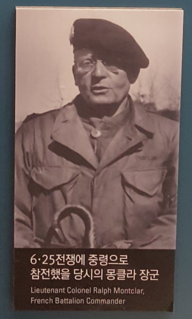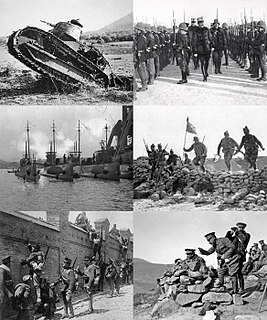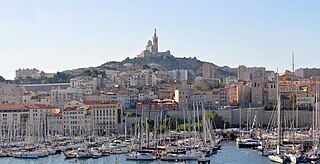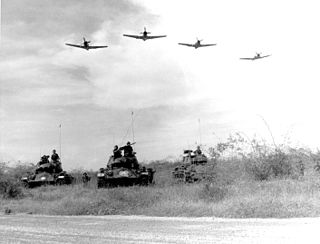
The 2nd Foreign Infantry Regiment is an infantry regiment of the French Foreign Legion. The regiment is one of two mechanized infantry regiments of the 6th Light Armoured Brigade.

Raoul Charles Magrin-Vernerey, other known as Ralph Monclar born 7 February 1892, was a French officer and 2nd Inspector of the Foreign Legion who fought in World War I, World War II within the ranks of the Free French Forces and led the French Battalion in the Korean War. He was also one of the first senior officers to respond to the Appeal of 18 June.
Félix Lucien Roger Debax was a French army officer and Olympic fencer. Born in Toulouse, Debax entered the army as an officer-candidate at the age of 18. After service with the infantry, he became attached to the army gymnastics school in 1889. He was transferred back to the infantry for two years from 1893, before returning to the ecole. Debax remained a gymnastics teacher until 1901 during which time he competed as a fencer at the 1900 Summer Olympics in Paris.
Lieutenant-General Henry Freydenberg was a French army officer. He was born in Paris on 14 December 1876 of German descent family.
General Henri Joseph Simon was a French army officer. He is particularly associated with the French protectorate of Morocco where he spent much of his army career. Simon served as head of intelligence to Hubert Lyautey and as director of the Moroccan Indigenous Affairs Service as well as conventional combat roles. He later wrote books about his time in Morocco and helped the production of the 1934 film Itto.
Lieutenant-Colonel René Philippe Laverdure was a French army officer. He enlisted in the army as a private soldier in 1880 and saw active service with the 1st Marine Infantry Regiment and the Regiment de Tirailleurs Annamites in the Tonkin Campaign in modern Vietnam. He was promoted through the army's non-commissioned ranks and became an adjutant in 1884. A display of bravery on the battlefield won him a commission later that year.

General Noël Marie Amédée Garnier-Duplessix or Duplessis was a French army officer. Whilst still a colonel he commanded the 2nd Infantry Division in the Allied victory at the First Battle of the Marne before seeing service in the Zaian War in the French protectorate of Morocco. Garnier-Duplessix returned to France in October 1916 and received command of the 37th Infantry Division for the 15 December offensive of the Battle of Verdun and the Nivelle Offensive of April 1917. He received command of the 9th Army Corps in June 1918 and led that unit to victory in the August Battle of Amiens and the autumn Meuse-Argonne Offensive. After the war he was posted to Cilicia in the Franco-Turkish War of 1918–21 where he argued against early withdrawal of troops following the March 1921 Cilicia Peace Treaty.

Colonel Marie Augstin Gaston Cros was a French army officer and archaeologist. He was born in Alsace and was displaced when that territory was incorporated into the German Empire. He joined the French Army as a lieutenant and saw action in Tonkin before spending several years surveying in Tunisia, receiving the honours of membership of Vietnamese and Tunisian orders and appointment as a chevalier of the Legion of Honour. In 1901 Cros was appointed head of the French archaeological expedition to Girsu, Iraq to continue the work of Ernest de Sarzec. His work over the next five years included the tracing of the 32.5 feet (9.9 m) thick city wall and for his work there received a letter of commendation from Gaston Doumergue, the Minister of Fine Arts, and the award of the Golden Palms of the Ordre des Palmes Académiques. Promoted to lieutenant-colonel, Cros served in the French protectorate of Morocco from 1913, seeing action in the Zaian War.
General Antoine Jules Joseph Huré was a French army officer and engineer noted for his service in Morocco. Huré joined the army as a volunteer in 1893 and after training at the École Polytechnique and École d'Application de l'Artillerie et du Génie he was commissioned into the 3rd Regiment of Engineers. He spent a number of years with his regiment and on staff appointments in France before transferring to Algeria first with the 19th Army Corps, and then the 15th Army Corps. In 1912 Huré transferred to the general staff in eastern Morocco and earned the Colonial Medal.

Walter Francis Chisholm Waddington was a French cavalry officer and general. Born in Dublin, Ireland to a British Army officer, he followed his father to France and enlisted in the cavalry. Commissioned within five years, he saw service in Madagascar and was made an officer of the Legion of Honour before being promoted to the rank of général de brigade. Waddington had command of the French 12th Dragoon Brigade in the Occupation of the Rhineland following the First World War, and died there at Mainz on 23 June 1920.
Henri Alexis Joseph Vanwaetermeulen was a French general of the First World War who began his career as a private soldier. Enlisting into a line regiment in 1883 Vanwaetermeulen was promoted to sergeant major within two years and received his commission within five. He transferred to the Troupes de marine and saw service in several French colonies. In Tonkin Vanwaetermeulen was mentioned in dispatches for leading assaults on two forts and received the Colonial Medal. He saw further service in Madagascar, Senegal and Mauritania, much of it under the command of Joseph Gallieni, and by the outbreak of the First World War was a lieutenant-colonel.

Joseph Maurice Pambet was a French army general. Volunteering for service in 1872 Pambet graduated from the Ecole Spéciale Militaire de Saint-Cyr and served with a number of line infantry and light infantry regiments, reaching the rank of captain by 1885. Having attended the École Militaire he became an adjutant to his regiment and then an aide to brigade and divisional generals. Returning to regimental service as a chef de bataillon Pambet began a nine-year tour of service in Tunisia from 1896.
Léon Amédée François Raffenel was a general of the French army. Enlisting into the army in 1875 he quickly rose through the ranks and was accepted into the Ecole Spéciale Militaire de Saint-Cyr in 1876. He saw extensive active service with the French colonial army in the Pacification of Tonkin between 1887 and 1892, being cited in the order of the day for his adept command of columns of native infantry. Having married in 1893 Raffenel requested transfer to the France-based metropolitan army in 1894. This unusual move was complicated by the separate organisation of the two French armies but was approved by presidential decree. Raffenel spent 16 years in the metropolitan army and commanded the 27th Infantry Regiment and the elite 82nd Light Infantry Brigade. He was promoted to général de brigade in 1911 and received command of the 3rd Colonial Infantry Division, one of the finest divisions of the French Army. He fought with this unit at the Battle of Rossignol on 22 August 1914 and was killed in action in what was a heavy defeat for the French troops.

Charles Rondony was a French general. Joining the metropolitan army as a private soldier in 1875 he rapidly rose through the ranks and was commissioned into the Troupes de marine in 1880. Serving in the Tonkin War in command of indigenous troops he was wounded during an attack on a fort, he was posted briefly to Senegal before returning to Tonkin in 1890. During the Pacification of Tonkin Rondony distinguished himself, being wounded twice in action, being cited in the order of the day, receiving the Tonkin and Colonial Medals and being appointed a commander of the Order of the Dragon of Annam. Returning to France in 1897 he was promoted to lieutenant-colonel and saw service in the Boxer Rebellion of 1900–01. Furthers postings in Tonkin and Madagascar followed before Rondony was promoted to général de brigade in France. Holding command of the 3rd Colonial Brigade upon the start of the First World War he led it in defeat at the Battle of Rossignol on 22 August 1914. Rondony and his divisional commander, Léon Amédée François Raffenel, were killed in action, the first French generals to die during the war.

Paul Emile Diou was a French general. Diou entered the army in 1873 and spent much of his early career superintending the training of army personnel. He saw extended service in Tunisia with the Army of Africa and also in the Far East. Diou was praised for his work in Morocco in 1908 and was subsequently appointed to brigade command. In the opening stages of the First World War he led his brigade in an attack on German positions and was mortally wounded.

Achille Pierre Deffontaines was a French general. He served in various metropolitan infantry regiments before becoming a staff officer in several divisions and army corps. Deffontaines became the youngest general in France on his promotion to général de brigade in 1913. He led the 24th Infantry Division into action in Belgium in one of the opening battles of the First World War. Deffontaines was shot in the head while commanding his troops in the field on 22 August and died in hospital four days later. He was the youngest French general to die during the war.
Louis Victor Plessier was a French general. Joining the army in 1874 Plessier fought in the Sino-French War and in Algeria. As a general in the First World War he led his brigade during the Battle of Mulhouse where he was wounded by German fire. Plessier, hit in three places in his spine, succumbed to his wounds eight days later in hospital. He is sometimes regarded as the first French officer to be killed during the war: although four other generals died before he did, his mortal wound was the first.
Serge Andolenko was a French military officer of Russian origin who became brigade général of the French Army.
Armand Louis Joseph Denis de Fitte de Soucy was a French soldier who served in Senegal, Guadeloupe and Martinique, and rose to the rank of divisional general. He was governor of Martinique from 1856 to 1859.





















